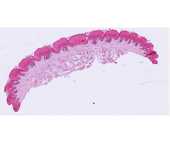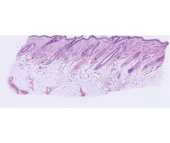Skin Slides
#4 Skin, thick skin, volar surface, H&E
Epidermis:
The stratified squamous keratinizing epithelium of the epidermis is made up primarily of keratinocytes. The form and function of these cells changes as they pass from basal to superficial locations. The layers of the epidermis from basement membrane to skin surface include:
Stratum basale: Cells of all the layers are generated from the keratinocytes in this layer. Therefore, you may see mitotic figures. The keratinocytes in this and the overlying layers contain melanin granules that have been transferred to them by melanocytes. The cytoplasm of melanocytes does not stain with H&E, giving the appearance of a halo. Special staining methods are required to identify melanocytes definitively.
Stratum spinosum: This is several cell layers in thickness. The cells are attached to each other by intercellular bridges (desmosomes). Because the cells pull apart during preparation, the attachment sites give the cells a spiny appearance.
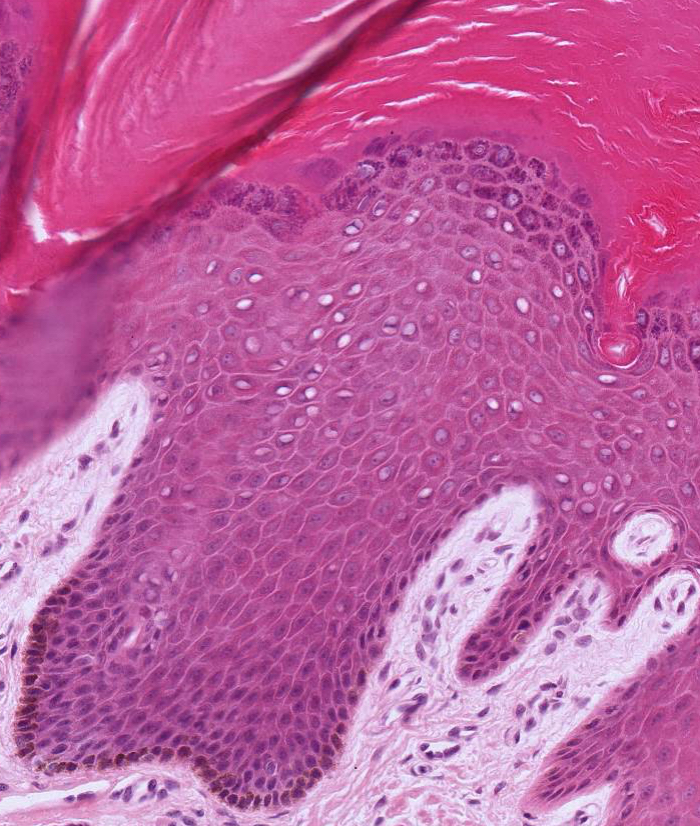 Stratum granulosum: The cells of this layer are recognizable by their basophilic keratohyalin granules containing filaggrin and other proteins binding tonofibrils.
Stratum granulosum: The cells of this layer are recognizable by their basophilic keratohyalin granules containing filaggrin and other proteins binding tonofibrils.
The stratum lucidum is not clearly identifiable in this slide.
Stratum corneum: The superficial keratinized layer is the stratum corneum, which protects the skin against friction, infection, and water loss. It consists of flattened, denucleated squames.
Dermis:
Papillary layer: loose connective tissue underlying the basal layer of the epidermis, and containing blood vessels, nerves and lymphatic vessels. Dermal papillae may contain sensory nerve endings called Meissner's corpuscles.
Reticular layer: dense, irregularly arranged connective tissue.
Subcutaneous tissue (hypodermis):
This is loose connective tissue containing abundant adipose tissue. It is a good region to examine glands, ducts, blood vessels and nerves.
Eccrine sweat glands are present in high concentration in the dermis and subcutaneous tissue. They are coiled tubular glands with an acidophilic margin, which corresponds to the layer of myoepithelium. The ducts are straight as they lead through the superficial dermis to the basal aspect of the epidermis. At this point they assume a coiled pathway, which becomes corkscrew-like in the stratum corneum.
Pacinian corpuscles are another type of nerve ending found in the dermis or subcutaneous tissue. They are made up of an axon surrounded by numerous concentric cellular lamellae. These are also found in other regions of the body.
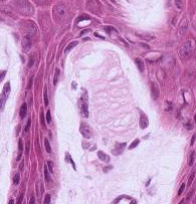

#46 Skin, scalp, human H&E
Hair follicles are well demonstrated in this slide in longitudinal section. The thin epidermis, characteristic of hairy regions, has a lacy or frayed stratum corneum whose appearance is an artifact of sectioning. In life, this layer of the epidermis would be more compact and only the most superficial keratinized cells would be desquamating.
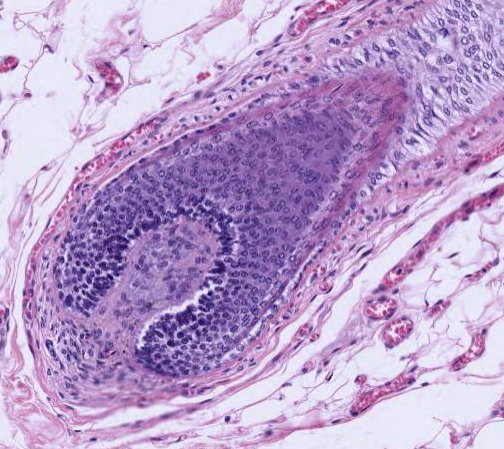 The deepest part of the hair follicle is expanded into a bulb and is invaginated by connective tissue, the dermal papilla. The follicle cells adjacent to the papilla are the germinative cells, which divide and differentiate to form the hair shaft and a multi-layered inner root sheath. Melanocytes are adjacent to the dermal papilla and contribute melanin granules to the developing hair. The fully formed hair is usually lost during slide preparation.
The deepest part of the hair follicle is expanded into a bulb and is invaginated by connective tissue, the dermal papilla. The follicle cells adjacent to the papilla are the germinative cells, which divide and differentiate to form the hair shaft and a multi-layered inner root sheath. Melanocytes are adjacent to the dermal papilla and contribute melanin granules to the developing hair. The fully formed hair is usually lost during slide preparation.
 Sebaceous glands are associated with the hair follicle and their secretions empty into the hair follicle, between the hair shaft and the follicle wall. The arrector pili muscle is a band of smooth muscle that inserts on the hair follicle, deep to the sebaceous glands. Superficially it inserts at the base of the epidermis. Some eccrine sweat glands are dispersed between the hair follicles.
Sebaceous glands are associated with the hair follicle and their secretions empty into the hair follicle, between the hair shaft and the follicle wall. The arrector pili muscle is a band of smooth muscle that inserts on the hair follicle, deep to the sebaceous glands. Superficially it inserts at the base of the epidermis. Some eccrine sweat glands are dispersed between the hair follicles.
